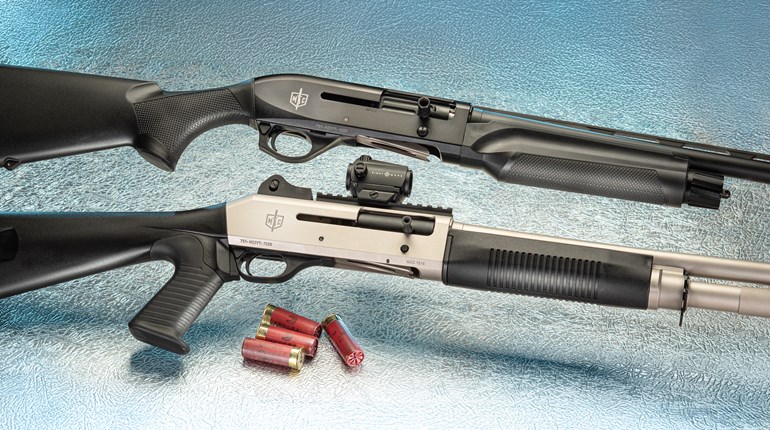
It's a changing world out there, and the challenges to our safety we face today are different from only a decade ago. Just look at the headlines. Terrorist attacks or natural disasters coupled with inadequate response from local authorities can leave thousands to fend for themselves. The looming threat of a manmade disaster or economic collapse poses the potential for social unrest. Any of these scenarios can result in large gangs of looters or worse. In today's world, staying safe and keeping your family protected requires a plan—and the means—for dealing with the threat of multiple attackers.
A shotgun is often the go-to firearm for home defense, but compared with a rifle or a handgun sporting a detachable magazine, there are some downsides—a shotgun has a very limited ammo capacity, and it is extremely slow to reload. Either of these drawbacks could become a serious handicap if you have to deal with several threats at once. The loading concern is tough to resolve, since shotguns with removable magazines have often encountered reliability problems. Increasing the magazine capacity of a shotgun takes care of much of these concerns.
Given that concept and based on the gun's 15-shot capacity alone, the new UTS-15 pump-action shotgun from UTAS USA is a compelling option for defensive situations. However, it's not just magazine capacity that makes the 12-gauge UTS-15 an effective fighting shotgun. The unique design, along with features that enhance its performance for defensive roles, also deserves some consideration.
The creator of the UTS-15 is Ted Hatfield, who has been in the gun industry longer than Moses was alive. Hatfield has made traditional and modern muzzleloaders, high-end double-barrel shotguns and other scatterguns for some of the big-name gun companies and private labels. He's also been a writer and an editor for several publications, including American Rifleman.
Hatfield's latest endeavor was developed in Turkey, and it takes full advantage of the modern design and manufacturing processes for which the country is increasingly becoming known. In fact, the UTS-15 name is partially derived from this two-country collaboration: The "U" is for United States, the "T" for Turkey, and the "S" for shotgun. The "15" obviously refers to the shotgun's ammo capacity. Early versions of the UTS-15 were manufactured in Turkey, but now UTAS has a facility near Chicago, IL, and produces the shotgun in the United States.
A bullpup-style shotgun having upper and lower receivers made from fiber-reinforced, injection-molded polymer, the UTS-15 uses a dual-tube magazine system. Each tube holds seven, 2 3/4-inch shells (or six, 3-inch magnum rounds). Add one more shell in the chamber, and the total capacity is 15 shells.
The magazine tubes can be used together, alternating feeding from one then the other or isolated to feed from only one tube at a time. You can load buckshot in one tube and slugs in the other, and selectively decide which type of ammo to use depending on the situation. Selecting the magazine is as simple as moving a lever located on top of the shotgun behind the tubes. Push the lever to the tube you do not want to use to block feeding. Switching magazines takes a fraction of a second. Keeping the lever in the center position does not block either tube, permitting shells to feed from both sides.
The bullpup design creates a gun that is short, measuring only about 28 inches, while the polymer used to make about 85 percent of the gun keeps the weight less than 7 pounds. That's unloaded, of course. A full capacity of 15 buckshot rounds adds approximately another 1.5 pounds to the total weight.
In addition, the length-of-pull is just 12 inches. A short length-of-pull is a benefit when wearing body armor, but more importantly for most civilians, it simply reduces the overall length of the UTS-15. If you prefer a longer length of pull, UTAS plans to offer thicker versions of the gun's buttpad to increase the dimension. Since the buttpad is held in place by a couple of easily removed pins, replacing it shouldn't be a problem.

Thanks to its compact design, the UTS-15 is easy to maneuver in close quarters, such as inside a building or when exiting a vehicle. The shotgun's pistol grip lets you hold, aim or fire it with one hand if necessary. This keeps the other hand free to dial a phone, turn on a light switch, open a door, throw a block or perform any other task it may be called upon to do—all while the gun remains in control and operable. The pistol grip also promotes a firm hold on the gun to prevent a bad guy from taking it away from you. While the pistol grip is polymer with a molded, pebble-like surface, the trigger guard is made of aluminum and leaves enough room around the trigger for operation when wearing gloves.
Like any other pump shotgun, the UTS-15 is cycled by sliding the fore-end backward and forward. As a shell exits the magazine, it drops into the action and is captured by a pivoting, forked lever. The lever holds the shell in line with the chamber until the bolt guides the round home. Imagine a carrier in a conventional shotgun, but upside down, because the magazines of the UTS-15 are above the chamber instead of below. The rotating bolt head has a spring-loaded extractor, and the ejector is a spring-loaded pin mounted on the side of the receiver. Serving as a cover for the feeding mechanism, the top half of the buttstock opens on a hinge to access the action for cleaning or clearing a jam. A magnetically latched, hinged, spring-loaded dustcover can be closed over the ejection port when the bolt is in battery.
Although operating the UTS-15 is straightforward, there are some areas where the procedure varies from that of standard pump-action shotguns. Loading the magazines takes place near the top of the receiver rather than the bottom. Each magazine is loaded independently by opening a door on either side of the receiver. Push the follower into the magazine until it clicks into place, making room at the rear of the tube for a shell, then load rounds in the normal fashion. When loading is complete, close the door to the magazine until it latches.
Vented covers on the outside of each magazine are marked with numbers, and a white stripe on each follower lines up with these markings to indicate the number of rounds in the tube. The markings on the magazine covers also tell the shooter at a glance how many rounds remain in each tube. To top off a partially loaded magazine, open the door and push two shells back up into the magazine, then add more.
Controls on the UTS-15 are also different than those found on most pump shotguns. The slide-release button is built into the bottom of the buttstock. Mounted on the left side of the receiver, the two-position, rotating safety is similar to that of an AR.
The UTS-15 has an 18.5-inch, smoothbore barrel that accepts choke tubes with Beretta-style threads. While the gun comes with a flush-fitting, cylinder-bore tube, an extended, cylinder-bore, breaching choke tube with ports and a serrated face is available as an option. Since any Beretta-style choke will work, you have almost limitless options for pattern control.
The buttstock's comb is straight and almost level with the top rail, so it raises the eye well above the barrel (think AR-15). As a tactical shotgun, the UTS-15 is designed to be used with sights, either optical or iron, mounted on the top rail. This is a shotgun meant to be aimed, not pointed, but unfortunately the UTS-15 does not come with sights. UTAS offers adjustable sights machined from a billet of 7000-series aluminum for the shotgun, but the company treats them as separate, optional accessories. The front sight consists of a protected post topped with a bead that is adjustable for elevation. A flip-up insert in the rear-sight assembly provides two aiming options: a large, ghost-ring aperture and a wide, V-notch. The rear assembly is adjustable for windage.
Any sights or optics designed for an AR-style rifle should work fine, as the offset between the receiver rail and the comb of the UTS-15 is similar to that of an AR. Mounting an optic with its center about 1.6 inches above the top of the rail is ideal, which is also true for an AR. However, note that with the UTS-15, the offset between the sights and the bore is greater than with an AR. The barrel is under the magazine tubes on the UTS-15, so the center of the bore will be about 4.5 inches below the center of an optic. This will affect the impact of slugs and tight shot patterns at close range. Just as with an AR, it's important to learn how the offset relates to impact for every distance you expect to shoot.

Better still for low-light situations, UTAS offers a version of the shotgun with a 200-lumen light/laser sight inside the fore-end. A switch mounted on the right side of the lower receiver allows the selection of light or laser mode. A light/laser kit is also available to fit the standard UTS-15 model. (Drilling the lower receiver to accommodate the rotating switch is required for installation.)
During testing, I put more than 1,300 shells through three different UTS-15 shotguns. While that was hard on my ammo supply, particularly in these times of shortages, shooting it gave me a lot of insight into what this gun can do.
The UTS-15's innovative design is reliable, but you can't get sloppy with your technique. It does not offer a lot of forgiveness for short-stroking. Like many pump-action shotguns, this one works best when you work it hard. The UTS-15 needs adequate slide speed to ensure positive ejection, so it's best to run it like you're trying to break it. Don't baby this gun; feel free to use some force when manipulating the slide.
I shot the UTS-15 on the clock and found if I tried to shoot it with splits of .4 second or faster, the ejected hull sometimes didn't escape the action fast enough to allow a complete cycle. The hull became captured in the action and led to a jam. Keep in mind this was very fast shooting—two shots in a bit more than three-quarters of a second. The reality is sustained split times below .4 second with a pump-action shotgun are the domain of very elite shooters. Outside of competition, overrunning the gun is unlikely to be a problem for most users.

I mention these things to stress the importance of deliberately cycling the gun. Any pump-action shotgun will operate most reliability when the backward and forward strokes are positive and complete. Don't try to get fancy; operate the UTS-15 smoothly and with force, and speed will take care of itself.
UTAS USA makes the 12-gauge shotgun even more effective for home defense with the UTS-15. Capacity has always been the shotgun's weak point, but having 15 rounds at your disposal pretty much eliminates that concern. The UTS-15 is a defensive machine that may well be the future of fighting shotguns. On top of that, I promise its unique profile is certain to draw a crowd at any shooting range.
Specifications
Manufacturer: UTAS USA; (847) 768-1011, utas-usa.com
Action Type: Pump-action bullpup shotgun
Gauge: 12; 3-inch chamber
Capacity: 14+1 (2 3/4-inch shells), 12+1 (3-inch shells)
Barrel Length: 18.5 inches
Receivers and Buttstock: Fiber-reinforced, injection-molded polymer
Length of Pull: 12 inches
Fore-end: Polymer
Sights: None; Picatinny rail for mounting sights and optics
Trigger Pull Weight: 4 pounds, 5 ounces
Length: 28.3 inches
Weight: 6 pounds, 14 ounces
MSRP: $1,200 (matte-black finish, tested), $1,400 (desert and camouflage finishes), $1,600 (Marine model with corrosion-resistant finishes applied to metal components)


































